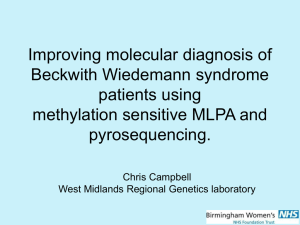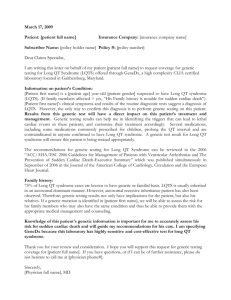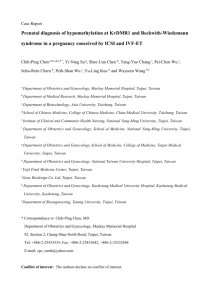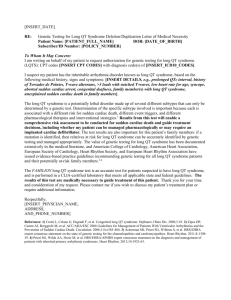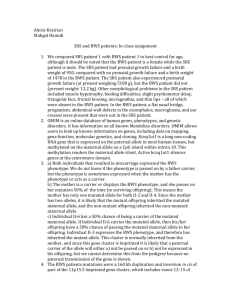- ePrints Soton
advertisement
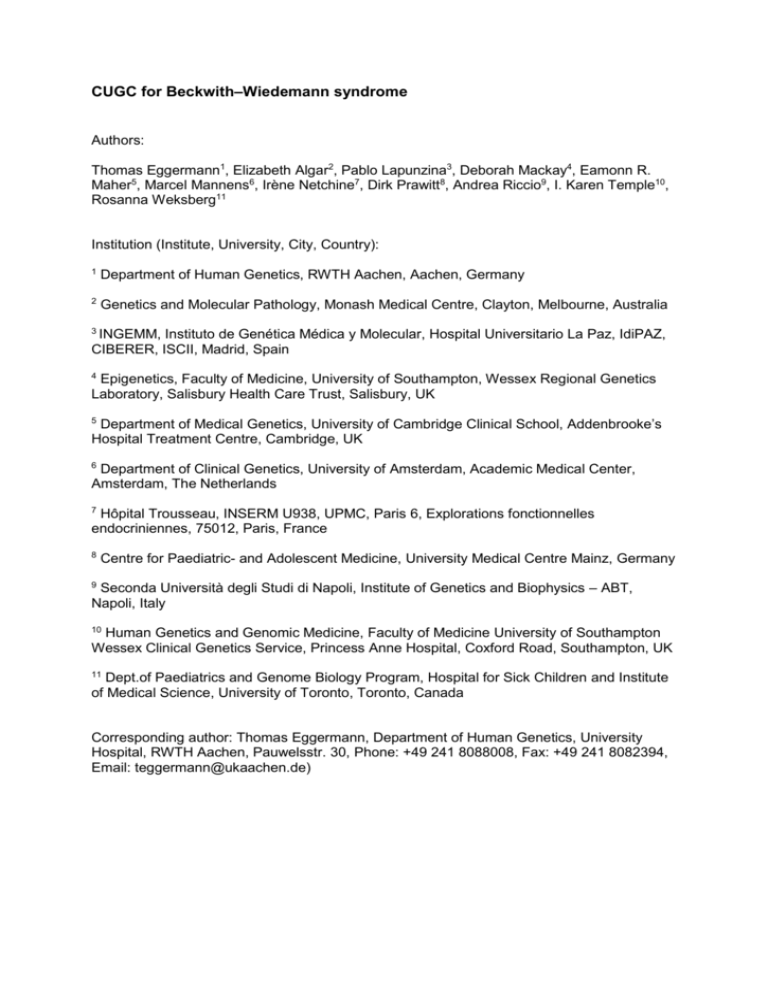
CUGC for Beckwith–Wiedemann syndrome Authors: Thomas Eggermann1, Elizabeth Algar2, Pablo Lapunzina3, Deborah Mackay4, Eamonn R. Maher5, Marcel Mannens6, Irène Netchine7, Dirk Prawitt8, Andrea Riccio9, I. Karen Temple10, Rosanna Weksberg11 Institution (Institute, University, City, Country): 1 Department of Human Genetics, RWTH Aachen, Aachen, Germany 2 Genetics and Molecular Pathology, Monash Medical Centre, Clayton, Melbourne, Australia 3 INGEMM, Instituto de Genética Médica y Molecular, Hospital Universitario La Paz, IdiPAZ, CIBERER, ISCII, Madrid, Spain 4 Epigenetics, Faculty of Medicine, University of Southampton, Wessex Regional Genetics Laboratory, Salisbury Health Care Trust, Salisbury, UK Department of Medical Genetics, University of Cambridge Clinical School, Addenbrooke’s Hospital Treatment Centre, Cambridge, UK 5 6 Department of Clinical Genetics, University of Amsterdam, Academic Medical Center, Amsterdam, The Netherlands 7 Hôpital Trousseau, INSERM U938, UPMC, Paris 6, Explorations fonctionnelles endocriniennes, 75012, Paris, France 8 Centre for Paediatric- and Adolescent Medicine, University Medical Centre Mainz, Germany Seconda Università degli Studi di Napoli, Institute of Genetics and Biophysics – ABT, Napoli, Italy 9 10 Human Genetics and Genomic Medicine, Faculty of Medicine University of Southampton Wessex Clinical Genetics Service, Princess Anne Hospital, Coxford Road, Southampton, UK 11 Dept.of Paediatrics and Genome Biology Program, Hospital for Sick Children and Institute of Medical Science, University of Toronto, Toronto, Canada Corresponding author: Thomas Eggermann, Department of Human Genetics, University Hospital, RWTH Aachen, Pauwelsstr. 30, Phone: +49 241 8088008, Fax: +49 241 8082394, Email: teggermann@ukaachen.de) 1. Disease characteristics 1.1 Name of the Disease (Synonyms): Beckwith-Wiedemann syndrome; BWS (exomphalos-macroglossia-gigantism syndrome/EMG syndrome; Wiedemann-Beckwith syndrome/WBS) 1.2 OMIM# of the Disease: 130650 1.3 Name of the Analysed Genes or DNA/Chromosome Segments: 11p15.5: Imprinting Control Region 1 (ICR1/IC1: i.e. H19, IGF2) Imprinting Control Region 2 (ICR2/IC2/KvDMR1: i.e. CDKN1C, KCNQ1, KCNQ1OT1/LIT1) 1.4 OMIM# of the Gene(s): ICR1: H19 IGF2 ICR2: CDKN1C KCNQ1OT1 (LIT1) KCNQ1 103280 147470 600856 604115 607542 1.5 Mutational Spectrum: #11p15.5 (based on data from the literaturefor review:1,2 and diagnostic cohorts from the authors): ICR1 hypermethylation 5-10% ICR2 hypomethylation 50-60% UPD(11p15)pat 20-25% CDKN1C point mutations3,4 1.3-5% in sporadic cases 20- 40% in familial cases duplication of paternal chromosome 11p15.5 1-2% ICR1 microdeletionsfor review: 5 <1% ICR2 microdeletions6 <1% Multilocus Methylation Defect in cases with ICR2 hypomethylation7,8 up to 25% mosaic genome-wide paternal uniparental disomy9,10 up to 1.4% 1.6 Analytical Methods: (MS methylation-specific) MS-MLPA; MS-Southern-Blot; MS-PCR; MS-SNuPE (Single Nucleotide Primer Extension); ASMM (Allele-Specific Methylation Multiplex)—RT-QPCR; MS high-resolution melting (HRM)11; MSpyrosequencing; Short tandem repeat marker typing; molecular karyotyping (SNP array, aCGH); qPCR; conventional cytogenetics; FISH with region-specific probes 1.7 Analytical Validation Parallel analysis of negative and positive controls. Determination of methylation and copy number reference ranges in unaffected individuals. 1.8 Estimated Frequency of the Disease (Incidence at birth ("birth prevalence") or population prevalence. If known to be variable between ethnic groups, please report): 1:13.700-17.000 1.9 Diagnostic Setting A. (Differential) diagnostics B. Predictive Testing C. Risk assessment in Relatives D. Prenatal Yes. x x x x No. Comment: Prenatal testing may be requested occasionally in cases of familial chromosomal rearrangements affecting chromosomes 11p15 or in case of familial CDKN1C point mutations. Prenatal diagnostic testing for BWS may be requested after detection of exomphalos, mesenchymal dysplasia or macroglossia and macrosomia by ultrasonography. Prenatal testing for genomic disturbances (duplications, point mutations) can be offered without limitations, but the prenatal application of methylation-specific tests is questionable due to the insufficient knowledge about the prenatal setting of the ICR1 and ICR2 imprinting marks and the mosaic pattern of these anomalies. More work in this area is needed. 2. Test characteristics 2.1 Analytical Sensitivity (proportion of positive tests if the genotype is present) 11p15.5: ICR1 hypermethylation >90%* ICR2 hypomethylation >90%* UPD(11p15)pat >90%* CDKN1C point mutations(mostly maternal) >95%° Aberrations/microdeletions in chromosome 11p15.5 nearly 100% Mosaic genomewide paternal uniparental disomy >90%* * due to their mosaic distribution some molecular defects might escape detection. The detection rate is significantly influenced by the tissue tested and by the sensitivity of the diagnostic method, but the relative analytical sensitivity of different methods has not yet been formally compared. °nearly 100% in case of de-novo point mutations, but low-level mosaicism might escape detection by the standard sequencing techniques. 2.2 Analytical Specificity (proportion of negative tests if the genotype is not present) Nearly 100% 2.3 Clinical Sensitivity (proportion of positive tests if the disease is present) The clinical sensitivity can be dependent on variable factors such as age or family history. In such cases a general statement should be given, even if quantification can only be made case by case. 70-80%, there is evidence that clinical BWS can be present without currently known molecular alteration or that mutations are detectable in patients not meeting the threshold diagnostic criteria for BWS. The sensitivity might be enhanced if tested in different tissues (e.g. fibroblasts or mouth wash DNA in addition to DNA from leucocytes). 2.4 Clinical Specificity (proportion of negative tests if the disease is not present) The clinical specificity depends on variable factors such as age or family history. In such cases a general statement should be given, even if a quantification can only be made case by case. Nearly 100% 2.5 Positive clinical predictive value (life time risk to develop the disease if the test is positive). Up to 100%, but depends on the type of the alteration and on the sex of the transmitting parent. Furthermore the phenotype can be very mild in positive cases. In the case of CDKN1C point mutations clinically unaffected mothers have been reported (probably because these mothers inherited the mutation from their father12,13), but functional proof of pathogenicity for some variants is lacking. In the case of monozygotic twins, clinical discordance is common with only one twin affected by BWS. However, both frequently display ICR2 hypomethylation of leukocyte DNA, because they share fetal circulation. In such circumstances other accessible tissues (skin fibroblasts, buccal cells) should be tested to demonstrate a normal ICR2 11p15 methylation in the non-affected twin. 2.6 Negative clinical predictive value (Probability not to develop the disease if the test is negative). Assume an increased risk based on family history for a non-affected person. Allelic and locus heterogeneity may need to be considered. Index case in that family had been tested: 100% (Caveat: For epimutations, heterogeneity cannot be excluded because the causative genetic factors are unknown) Index case in that family had not been tested: 1% (Caveat: difficult to estimate) 3. Clinical Utility 3.1 (Differential) diagnostics: The tested person is clinically affected As BWS is clinically heterogeneous and the clinical diagnosis is sometimes difficult, the identification of a molecular aberration in 11p15 excludes other (genetic) overgrowth syndromes with different recurrence risks and different prognoses. A phenotypic overlap with other overgrowth syndromes exists mainly for Sotos, Simpson–Golabi –Behmel, Weaver and Perlman syndromes. 3.1.1 Can a diagnosis be made other than through a genetic test? No. Yes, (continue with 3.1.4) x clinically. x imaging . endoscopy. biochemistry. electrophysiology. other (please describe): A clinical examination may suggest the diagnosis even if genetic testing cannot confirm it. 3.1.2 Describe the burden of alternative diagnostic methods to the patient The clinical diagnosis is not associated with additional invasive procedures for the patient. 3.1.3 How is the cost effectiveness of alternative diagnostic methods to be judged? Due to the clinical heterogeneity, the clinical diagnosis can sometimes be doubtful. The molecular prove of a 11p15 epimutation/mutation precludes further investigations for overgrowth. 3.1.4 Will disease management be influenced by the result of a genetic test? No. Yes. x Therapy (please describe) x Certainty of diagnosis aids medical management. Indeed, the treatment of hypoglycaemia, abdominal wall repair, endotracheal intubation, tongue reduction surgery, and further surgical should be based on symptoms rather than on the genetic diagnosis. Prognosis (please describe) x Relatively good, but a significantly increased risk for neoplasia has to be considered Management (please describe) x Neoplasias should be treated according to standard paediatric oncology protocols. However, the need for surveillance in some molecular subtypes is controversial and some national guidelines do not advocate screening in all situations whereas others currently continue with screening as a precaution. A consensus on tumour surveillance is currently in discussion, and national guidelines need harmonisation. Suggested neoplasia screening for BWS patients age 0–4 years is abdominal ultrasound (US) every 3 months which should detect nephroblastomas, hepatoblastomas as well as the rare neuroblastomas, adrenocortical carcinomas and rhabdomyosarcomas. For patients aged 4–8 years a renal US every 3 months is recommended as a sufficient imaging method for detecting Wilms Tumour (WT). However, the risk of Wilms tumour varies according to the molecular subtype2,14,15 and some centres adjust screening protocols to reflect this16, e.g. in case of ICR1 hypermethylation, dup(11p)pat and UPD(11p15)pat, screening may be more intensive, AFP screening is advised and scanning may continue until adolescence. Current evidence from cohort studies suggests that ICR2 hypomethylation and CDKN1C mutations are not associated with increased risk for WT, though increased risk for hepatoblastoma cannot be discounted. In some centres, patients with these molecular findings do not have US every 3 months but have clinical examination every 3 months and targeted imaging if clinical symptoms appear, whereas in other centres AFP levels are measured in these patients every 6–12 weeks until the age of 4 years (95% of the reported BWS associated hepatoblastomas developed by this age).In some centres there is no surveillance. Caveat: AFP values tend to be increased in BWS patients both with and without hepatoblastoma, and many centres think the test is not a good screening test 17,18. Note that, if molecular screening is negative in a patient with the clinical diagnosis of BWS with hemihypertrophy, the patient should still be screened as if affected and considered at risk for neoplasia especially if there is a nephromegaly detectable by US. In case of a genome-wide paternal uniparental disomy longer tumour surveillance might be necessary. 3.2 Predictive Setting: The tested person is clinically unaffected but carries an increased risk based on family history (To be answered if in 1.9 "B" was marked) 3.2.1 Will the result of a genetic test influence lifestyle and prevention? If the test result is positive (please describe) If the test result is negative (please describe) BWS can be difficult to diagnose after early childhood when growth can be normal. Mosaicism can mean that external clinical features are minimal. If the test is positive it is important to consider the relatively high risk for neoplasia in the case of UPD(11p15)pat or ICR1 hypermethylation. The risk to develop cancer in adulthood is unknown. It has been shown that assisted reproductive technology (ART) enhances the risk for BWS recurrence19,20. 3.2.2 Which options in view of lifestyle and prevention does a person at-risk have if no genetic test has been done (please describe)? Such an individual may continue to have unnecessarily high anxiety about the risk of neoplasia or not know of the risk. Anxiety may also include concern about transmission to the next generation. Genetic testing might provide further clarity. 3.3 Genetic risk assessment in family members of a diseased person The majority of molecular alterations in BWS occurs sporadically (aberrant ICR1 and ICR2 methylation, UPD(11p15)pat). However single families have been reported with ICR1 and ICR2 microdeletions, chromosomal rearrangements of 11p15 and CDKN1C point mutations wherein a risk of up to 50% can be estimated. Multilocus Methylation Defects have been identified in a family with two sibs21 and were published to be associated with mutations within the NALP2. Thus, it is difficult to provide an accurate risk assessment due to unknown nature of some of the underlying genetic and environmental factors and the risk of having a second affected child cannot be ruled out. 3.3.1 Does the result of a genetic test resolve the genetic situation in that family? Yes (Caveat: predisposing genetic and environmental factors as the cause for some epimutations are the subject of ongoing research) 3.3.2 Can a genetic test in the index patient save genetic or other tests in family members? yes 3.3.3 Does a positive genetic test result in the index patient enable a predictive test in a family member? yes 3.4 Prenatal diagnosis (To be answered if in 1.9 "D" was marked) 3.4.1 Does a positive genetic test result in the index patient enable a prenatal diagnosis? In case of genomic alterations, i.e. ICR1 and ICR2 microdeletins, chromosomal aberrations and CDKN1C mutations, prenatal testing can be considered. 4. If applicable, further consequences of testing Please assume that the result of a genetic test has no immediate medical consequences. Is there any evidence that a genetic test is nevertheless useful for the patient or his/her relatives? (Please describe) The identification of a mutation or epimutation allows a more precise delineation of a recurrence risk for the patient and his or her family as well as providing important information concerning tumour risk stratification. Acknowledgement This work was supported by EuroGentest2 (Unit 2: “Genetic testing as part of health care”), a Coordination Action under FP7 (Grant Agreement Number 261469) and the European Society of Human Genetics. TE and DP are supported by the German Ministry of education and sciences BMBF (Network “Imprinting Diseases”, 01GM1114), Authors 1-8 are members of the COST Action BM1208. IN is supported by grant from APHP, INSERM, Agence nationale de la recherché and Agence de Biomedecine and FIS; PL by a grant from ISCIII. Conflict of Interest The authors declare no conflict of interest. References: 1. Shuman C, Beckwith JB, Smith AC, Weksberg R: Beckwith-Wiedemann Syndrome. In: Pagon RA, Bird TD, Dolan CR, Stephens K, Adam MP, editors. GeneReviews™ [Internet]. Seattle (WA): University of Washington, Seattle; 1993-2000 Mar 03 [updated 2010 Dec 14]. 2. Cooper WN, Luharia A, Evans GA et al: Molecular subtypes and phenotypic expression of Beckwith-Wiedemann syndrome. Eur J Hum Genet 2005; 13: 1025-32. 3. Lam WW, Hatada I, Ohishi S, et al: Analysis of germline CDKN1C (p57KIP2) mutations in familial and sporadic Beckwith-Wiedemann syndrome (BWS) provides a novel genotype-phenotype correlation. J Med Genet 1999; ;36:518-23. 4. Algar E, Brickell S, Deeble G, Amor D, Smith P: Analysis of CDKN1C in Beckwith Wiedemann syndrome. Hum Mutat 2000;15: 497-508. 5. Beygo J, Citro V, Sparago A, et al: The molecular function and clinical phenotype of partial deletions of the IGF2/H19 imprinting control region depends on the spatial arrangement of the remaining CTCF-binding sites. Hum. Mol. Genet 2013: November 12, 2012 [Epub ahead of print] 6 Zollino M, Orteschi D, Marangi G, et al: A case of Beckwith-Wiedemann syndrome caused by a cryptic 11p15 deletion encompassing the centromeric imprinted domain of the BWS locus. J Med Genet 2010; 47: 429-32. 7 Bliek J, Verde G, Callaway J, Maas SM, et al: Hypomethylation at multiple maternally methylated imprinted regions including PLAGL1 and GNAS loci in Beckwith-Wiedemann syndrome. Eur J Hum Genet 2009; 17: 611-619. 8. Azzi S, Rossignol S, Steunou V, et al. Multilocus methylation analysis in a large cohort of 11p15-related foetal growth disorders (Russell Silver and Beckwith Wiedemann syndromes) reveals simultaneous loss of methylation at paternal and maternal imprinted loci. Hum Mol Genet 2009; 18: 4724-33. 9. Wilson M, Peters G, Bennetts B, et al: The Clinical Phenotype of Mosaicism for Genome-wide Paternal Uniparental Disomy: Two New Reports. Am J MedGenet 2008; 146:137-148. 10. Gogiel M, Begemann M, Spengler S et al: Genome-wide paternal uniparental disomy mosaicism in a woman with Beckwith-Wiedemann syndrome and ovarian steroid cell tumour. Eur J Hum Genet 2012; doi: 10.1038/ejhg.2012.259. [Epub ahead of print] 11. Alders M, Bliek J, vd Lip K, vd Bogaard R, Mannens M: Determination of KCNQ1OT1 and H19 methylation levels in BWS and SRS patients using methylation-sensitive high-resolution melting analysis. Eur J Hum Genet 2009; 17: 467-473. 12. Romanelli V, Belinchón A, Benito-Sanz S, et al: CDKN1C (p57(Kip2)) analysis in BeckwithWiedemann syndrome (BWS) patients: Genotype-phenotype correlations, novel mutations, and polymorphisms. Am J Med Genet 2010; 152: 1390-1397. 13. Romanelli V, Belinchón A, Campos-Barros A, et al: CDKN1C mutations in HELLP/preeclamptic mothers of Beckwith-Wiedemann Syndrome (BWS) patients. Placenta 2009; 30: 551-554. 14. Bliek J, Maas SM, Ruijter JM, Hennekam RCM, Alders M. Westerveld A, Mannens MMAM: . Increased tumour risk in BWS patients correlates with aberrant H19 and not KCNQ1OT1 methylation: occurrence of KCNQ1OT1 hypomethylation in familial cases of BWS. Hum Mol Genet 2001: 10: 467476. 15. Bliek J, Gicquel C, Maas S, Gaston V, le Bouc Y, Mannens M: Epigenotyping as a tool for the prediction of tumour type and tumour risk in Beckwith-Wiedemann syndrome patients. J Ped 2004: 145; 796-799 16. Scott RH, Walker L, Olsen ØE, et al:. Surveillance for Wilms tumour in at-risk children: pragmatic recommendations for best practice. Arch Dis Child 2006; 91: 995-999. 17. Weksberg R, Shuman C, Beckwith JB: Beckwith–Wiedemann syndrome. Eur J Hum Genet 2010; 18: 8–14. 18. Teplick A, Kowalski M, Biegel JA, Nichols KE: Educational paper: screening in cancer predisposition syndromes: guidelines for the general pediatrician. Eur J Pediatr 2011;170: 285-294. 19. Lim D, Bowdin SC, Tee L, et al:. Clinical and molecular genetic features of BeckwithWiedemann syndrome associated with assisted reproductive technologies. Hum Reprod. 2009: 24: 741-747. 20 Gicquel C, Gaston V, Mandelbaum,J, Siffroi JP, Flahault A, Le Bouc Y: In vitro fertilization may increase the risk of Beckwith-Wiedemann syndrome related to the abnormal imprinting of the KCN1OT gene. Am J Hum Genet 2003; 72: 1338-1341. 21. Meyer E, Lim D, Pasha S, Tee LJ, et al : Germline mutation in NLRP2 (NALP2) in a familial imprinting disorder (Beckwith-Wiedemann Syndrome). PLoS Genet 2009: 5: e1000423.
